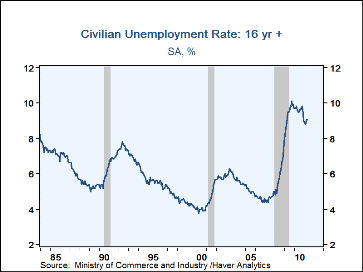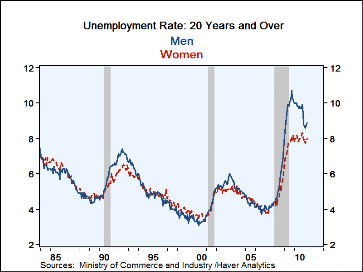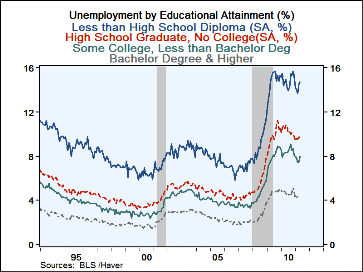 Global| Jun 08 2011
Global| Jun 08 2011U.S. Unemployment Varies Greatly By Age, Race, Educational Attainment & Gender
by:Tom Moeller
|in:Economy in Brief
Summary
A news headline announced that the overall May unemployment rate unexpectedly edged up to 9.1%. The Labor Department's figures painted a picture not only of higher unemployment but of great variation in conditions by gender, age, [...]
A news headline announced that the overall May unemployment rate unexpectedly edged up to 9.1%. The Labor Department's figures painted a picture not only of higher unemployment but of great variation in conditions by gender, age, ethnicity, and education. As the table below indicates, nearly two years into the current economic recovery, unemployment remains stubbornly high across categories.
The overall unemployment rate indeed is down one full percentage point from its high in October, 2009. However, several factors clearly suggest that the decline has been remarkably slow. To start, the drop compares to declines of 3-to-5 percentage points after the severe recessions of 1973-75 and 1981-82. During the comparatively slow recovery following the moderate 2001 recession, the rate still fell by roughly two percentage points in the two years after its peak. Currently, the slow fall in overall unemployment reflects little-or-no decline in the rate amongst blacks, women, and those with advanced education degrees. Even for white males, the decline in unemployment has been modest.
All of these numbers do not directly reflect those who have dropped out of the labor force. Currently, the labor force participation rate of 64% is the lowest percentage since early-1985. The drop reflects a decline amongst men to 71% from 76% but a rise in women's participation to 59% from 55%. (From an historical perspective, the decline in men's participation is from 86% sixty years ago and an increase in women's from 33% during that period.)
Near-term, declines in the unemployment rate are likely to be hard to come by. Recent economic momentum has slowed significantly with Q1 real GDP growth of just 1.8%. Forecasts for growth also have fallen. The National Association for Business Economics recently took its number for growth this year down to 2.8% with an unchanged, and only moderate, 3.2% rise next year. Slow growth is expected to leave the unemployment rate still-high at 8.2% for 2011 versus its pre-recession low of 4.6%.
The figures referenced above are available in Haver's LABOR database.
U.S. Labor Force Trends is from the Population Reference Bureau and it can be found here.
| Selected Employment Indicators | May | Apr | Mar | Y/Y | 2010 | 2009 | 2008 |
|---|---|---|---|---|---|---|---|
| Total Unemployment Rate (%) | 9.1 | 9.0 | 8.8 | 9.6 | 9.6 | 9.3 | 5.8 |
| By Sex | |||||||
| Male | 9.5 | 9.4 | 9.3 | 10.4 | 10.5 | 10.4 | 6.1 |
| Female | 8.5 | 8.4 | 8.3 | 8.8 | 8.6 | 8.1 | 5.4 |
| By Ethnicity & Age | |||||||
| White | 8.0 | 8.0 | 7.9 | 8.8 | 8.7 | 8.5 | 5.2 |
| 16-19 | 20.7 | 22.3 | 21.6 | 24.2 | 23.2 | 21.9 | 16.7 |
| 20 Years & Over | 7.6 | 7.5 | 7.3 | 8.1 | 8.2 | 7.9 | 4.7 |
| Black or African American | 16.2 | 16.1 | 15.5 | 15.5 | 16.0 | 14.8 | 10.1 |
| 16-19 | 40.7 | 41.6 | 42.1 | 38.5 | 43.1 | 39.6 | 31.1 |
| 20 Years & Over | 15.3 | 15.1 | 14.5 | 14.6 | 14.9 | 13.7 | 9.1 |
| By Educational Attainment | |||||||
| Less than HS | 14.7 | 14.6 | 13.7 | 14.9 | 14.9 | 14.7 | 9.0 |
| HS, no college | 9.5 | 9.7 | 9.5 | 10.8 | 10.3 | 9.8 | 5.7 |
| Some college or associate degree | 8.0 | 7.5 | 7.4 | 8.3 | 8.4 | 8.0 | 4.6 |
| Bachelors degree or higher | 4.5 | 4.5 | 4.4 | 4.6 | 4.7 | 4.6 | 2.6 |
Tom Moeller
AuthorMore in Author Profile »Prior to joining Haver Analytics in 2000, Mr. Moeller worked as the Economist at Chancellor Capital Management from 1985 to 1999. There, he developed comprehensive economic forecasts and interpreted economic data for equity and fixed income portfolio managers. Also at Chancellor, Mr. Moeller worked as an equity analyst and was responsible for researching and rating companies in the economically sensitive automobile and housing industries for investment in Chancellor’s equity portfolio. Prior to joining Chancellor, Mr. Moeller was an Economist at Citibank from 1979 to 1984. He also analyzed pricing behavior in the metals industry for the Council on Wage and Price Stability in Washington, D.C. In 1999, Mr. Moeller received the award for most accurate forecast from the Forecasters' Club of New York. From 1990 to 1992 he was President of the New York Association for Business Economists. Mr. Moeller earned an M.B.A. in Finance from Fordham University, where he graduated in 1987. He holds a Bachelor of Arts in Economics from George Washington University.












